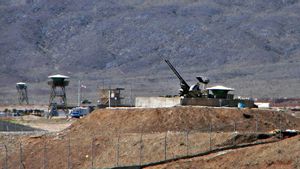JAKARTA - The Japanese government on Tuesday, April 13, decided to release the processed radioactive water collected at the Fukushima Daiichi Nuclear Power Plant (PLTN) into the sea.
Assessing this radioactive discharge will not have a negative impact on humans. The process involves plant operator Tokyo Electric Power Company Holdings Inc (Tepco)
"The release of the water will begin in about two years and the whole process is expected to take decades", the Japanese Government said as reported by Reuters on Tuesday, April 13.
Tepco has struggled with a buildup of contaminated radioactive water since controlling three reactors after the 2011 earthquake and tsunami that shut down electricity and cooling.
Long Process
Tepco uses an emergency pump and pipe systems to inject water into damaged reactor vessels, to keep melted uranium fuel rods cool.
Water is contaminated when it comes into contact with fuel before leaking into damaged basements and tunnels, mixed with groundwater flowing through the site from the hills above it. The combination results in excess contaminated water being pumped out and processed before being stored in a large tank that meets the site.
The tanks now hold about 1.3 million tons of radioactive water, enough for about 500 Olympic-sized swimming pools.
In an effort to address the problem, a 'wall of ice' was built around the reactor and a damaged well to draw groundwater before it reached the reactor. This action has slowed down, but not stopped the buildup of contaminated the water.

For years, Tepco has also fought leaks, spills, malfunctioning equipment, and safety violations, blocking cleanup efforts that are expected to run for decades.
In 2018, Tepco claimed to have not filtered all harmful substances from the water, despite saying for years those ingredients had been disposed of.
Before being dumped into the ocean, Tepco plans to filter contaminated water again to remove isotopes, leaving only tritium, a radioactive isotope of hydrogen that is difficult to separate from water. Tepco will then dilute the water until tritium levels drop below the specified limit, before pumping it directly into the sea from the beach location.
The water containing tritium is routinely released from nuclear plants around the world and Fukushima water release into the ocean is supported by regulatory authorities.
Tritium is considered relatively harmless because it does not expend enough energy to penetrate human skin. However, when ingested it can increase the risk of cancer, a Scientific American article said in 2014.
SEE ALSO:
The first water release is expected to be realized within the next two years, in accordance with the time, Tepco will use to start filtering water, building infrastructure, and obtaining regulatory approvals.
Until then, the buildup of contaminated water will continue, with the annual cost of water storage estimated at about 100 billion yen or about USD 912.66 million.
Overall, the disposal process after it begins will take decades to complete, with the filtration and dilution process rolling in, along with the planned plant shutdown.
The English, Chinese, Japanese, Arabic, and French versions are automatically generated by the AI. So there may still be inaccuracies in translating, please always see Indonesian as our main language. (system supported by DigitalSiber.id)


















